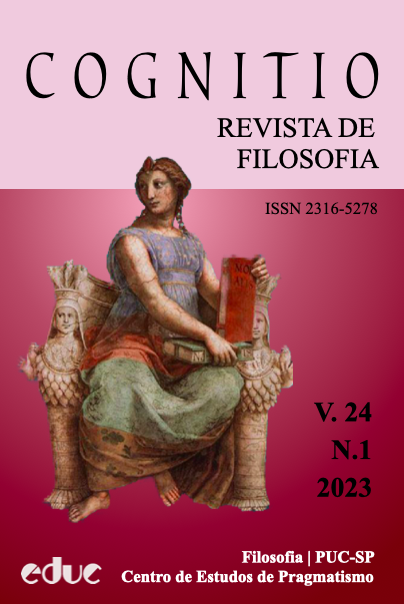Realismo seletivo, empirismo construtivo e o problema da continuidade teórica
DOI:
https://doi.org/10.23925/2316-5278.2023v24i1:e61817Resumo
No decorrer do debate sobre o realismo científico, alguns antirrealistas, tal como Leo Tolstói e Larry Laudan, criaram um desafio cético para os realistas, questionando, com base na história da ciência, a crença realista de continuidade entre as teorias do passado, atuais e futuras. Stathis Psillos ofereceu uma réplica que ficou conhecida como realismo seletivo ou divide et impera, alegando que, através de um minucioso exame, podemos encontrar elementos teóricos de continuidade entre teorias passadas e atuais, assegurando, por analogia, que as teorias futuras também possuirão elementos de continuidade com as atuais. A estratégia de Psillos, se bem empregada, pode evidenciar que a leitura realista de história da ciência também possui suas virtudes e deve ser considerada. Todavia, no presente artigo, argumentamos que mesmo que o realismo seletivo de Psillos se mostre aplicável, ele deve ser considerado como uma crítica a concepções descontinuístas em história da ciência e não necessariamente ao antirrealismo científico em geral, posto que o empirismo construtivo de Bas van Fraassen, por exemplo, admite a continuidade teórica na ciência.
Referências
CHAKRAVARTTY, Anjan. A Metaphysics for Scientific Realism: Knowing the Unobservable. Cambridge University Press, 2007.
DUTRA, Luiz Henrique de Araújo. Introdução à Teoria da Ciência. 4a ed. Florianópolis: Ed. Da UFSC, 2017. LAUDAN, Larry. A confutation of convergent realism. Philosophy of Science, v. 48, n. 1, p. 19-49, 1981.
[https://doi.org/10.1086/288975].
LIPTON, Peter. Inference to the Best Explanation. London: Routledge, 2004.
LYONS, Timothy. Scientific Realism and the Stratagema de Divide et Impera. The British Journal for the Philosophy of Science, v. 57, n. 3, p. 537-560, 2006. [https://doi.org/10.1093/bjps/axl021].
OKRUHLIK, Kathleen. A Filosofia da Ciência de Bas van Fraassen e o seu Voluntarismo Epistêmico. Trad. Alessio Gava. TRANS/FORM/AÇÃO: Revista De Filosofia, v. 44, n. 4, p. 399-416, 2021. [https://doi. org/10.1590/0101-3173.2021.v44n4.30.p399].
OLIVEIRA, Tiago Luís Teixeira. Algumas razões para levar a sério a Metaindução Pessimista. Principia, v. 18, n. 2, p. 269-290, 2014. [https://doi.org/10.5007/1808-1711.2014v18n2p269].
PSILLOS, Stathis. Scientific realism and the “pessimistic induction”. Philosophy of Science, v. 63, n. 3, p. S306-S314, 1996. [https://doi.org/10.1086/289965].
PSILLOS, Stathis. Scientific Realism: how Science tracks Truth. London: Routledge, 1999.
PSILLOS, Stathis. The Fine Structure of Inference to the Best Explanation. Philosophy and Phenomenologi-
cal Research, v. 74, n. 2, p. 441-448, 2007. [https://doi.org/10.1111/j.1933-1592.2007.00030.x].
PSILLOS, Stathis. Tolstoy’s Argument: Realism and the History of Science. Spontaneous Generations: A Journal for the History and Philosophy of Science, v. 9, n. 1, p. 68-77, 2018. [https://doi.org/10.4245/sponge. v9i1.28059].
STANFORD, Kyle. A Fond Farewell to “Approximate Truth”?. In Spontaneous Generations: A Journal for the History and Philosophy of Science, v. 9, n. 1, p. 867-878, 2018. [https://doi.org/10.4245/sponge. v9i1.28057].
STANFORD, Kyle. Exceeding our grasp. Oxford: Oxford University Press, 2006.
TOLSTÓI, Leo. Essays & Letters. Trans. Aylmer Maud. New York: Funk and Wagnalls Company, 1904.
VAN FRAASSEN, Bas. A imagem científica. Trad. Luiz Henrique Dutra. São Paulo: Discurso Editorial, 2007.
VAN FRAASSEN, Bas. Structure: Its Shadow and Substance. The British Journal for the Philosophy of Sci- ence, v. 57, n. 2, p. 275-307, 2006. [https://doi.org/10.1093/bjps/axl002].
VAN FRAASSEN, Bas. The Scientific Image. Oxford: Oxford University Press, 1980.
Downloads
Publicado
Como Citar
Edição
Seção
Licença
Copyright (c) 2023 http://creativecommons.org/licenses/by/4.0/

Este trabalho está licenciado sob uma licença Creative Commons Attribution 4.0 International License.









